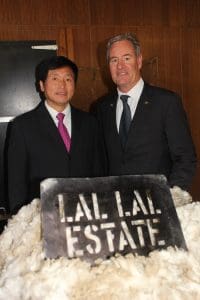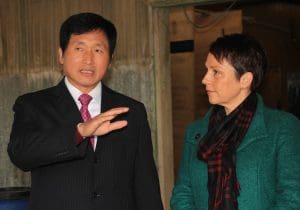
Tianyu Wool managing director Qingnan Wen, left, with former Lal Lal Estate owner Geoff Fisken.
VICTORIAN wool growers are investigating long-term supply contracts with major Chinese buyer and processor Tianyu Wool.
Sheep Central has been told at least 10 wool growers have shown interest in the possibility of long-term contracts, but details have not been finalised and no contracts have been drawn up.
Tianyu Wool is among the top ten buyers of Australian wool, purchasing about 6.5 percent of the clip at auction. In 2015, as China’s largest wool topmaker and scourer, the company had a scoured wool capacity of 80,000 tonnes, producing 20,000 tonnes of wool tops.
At a meeting in Buninyong last Tuesday, the growers agreed to discuss potential contract terms, initially for the supply of a trial 1000-bale shipment to Tianyu Wool. No other exporters are involved at this stage.
Discussions have included contract terms of three to 10 years, including rolling five-year agreements, at prices of $18-$22/kg clean for 19 micron fleece, but could involve wool from 18-24 microns. Prices would be based on spot auction market rates.
The trial would involve improved feedback to growers on how the wool processed and eventually a focus on non-mulesed wool production to give a marketing advantage. It is believed any initial contracts, if successful, could be expanded to involve supplies from other growers to additional Chinese processors.
Click here to get the latest Sheep Central story links sent to your email inbox.
Some of the growers investigating contracts attended the China Wool Industrial Association ‘Wool Salon’ on Friday at the 2000 hectare Yendon property Lal Lal Estate, bought by Tianyu Wool managing director Qingnan Wen three years ago from former WoolProducers Australia president Geoff Fisken.
The property has been valued at around $20 million and is currently running about 12,000 fine wool Merinos for fibre and prime lamb production.
Building a wool bridge
The 30th annual CWIA Wool Salon was the first outside China and with its theme ‘From Farm to Fashion’ was promoted by Mr Wen as a major step in “building a wool bridge” between Australia and China. He wants Lal Lal Estate to be a catalyst for collaboration and scientific advances in farm management, flock genetics, breeding and wool growing while returning the industry to profitability. CWIA members among the 130 delegates at the Lal Lal conference have been estimated to purchase $2 billion of Australian wool each year.
Mr Wen mentioned the grower contract negotiations at the Lal Lal conference, and has openly expressed his desire to look at options to the auction system to avoid price and supply volatility, including ongoing direct wool supplies from farms. However, clarifying recent media comments attributed to him, Mr Wen on Friday he told reporters he had not said he wanted to abandon Australia’s wool auction system.
Mr Fisken is employed as a consultant to Lal Lal Estate and said he was “a friend of Mr Wen’s who is trying to establish some sort of grower-processor connect.”
“The facts are that we’ve got nothing up at the moment, we’ve got interest in having further discussions, which we will be doing.”
Mr Fisken said as a former wool grower he had been “terribly frustrated” with wool auction market volatility. He agreed wool price volatility was an issue for buyers and growers.
“I think the volatility is more of an issue than the price itself.”
Wool auction system is “fair,” but “a roller coaster”

Tianyu Wool managing director Qingnan Wen, with Victorian Minister for Agriculture Jaala Pulford.
Mr Wen told Sheep Central through through an interpreter that he “never said that I wanted to eliminate the open cry auction system.”
“I think the auction system is good, it’s fair, I never said that we don’t want it,” he said.
“But what I’m thinking that the wool market in Australia is like taking a roller coaster and now with wool prices very high, everyone is very happy, but when the wool prices get down to the bottom you can see there are a lot of miserable things happen.
“So what I would like to see is that we work together to see how we could stabilise the supply chain in order to make everyone share the profits in this pipeline, otherwise someone one day will making a lot of money, but someone making a big loss.”
Mr Wen said this price volatility was not good for the long-term health of the industry.
In his address to the CWIA meeting, Mr Wen said a lot of Chinese know and appreciate the beauty of Australia, but few, including many CWIA members, have been to a real farm.
“I really would like to share the beauty with most of the Chinese visitors,” he said.
Mr Wen’s plans for the Lal Lal Estate including featuring as a wool tourism destination and as a platform for farm manager’s to share their experiences.
He intends to establish a museum to talk about the history of the industry as well as a sheep and wool demonstration centre. A new shearing shed and pasture improvement is also on his agenda.
Mr Wen said there should be more promotion about the history to develop a greater appreciation for wool and more communication with growers to encourage development and help transform the industry.
Mr Wen said the survival rates of sheep and on-farm management also needed to be improved to build the flock. He said a dream of his was that more young people come into the industry.
Minister for Agriculture, Jaala Pulford, welcomed the 130 delegates representing China’s 80 major wool processors as a show of strength for increasing demand for Australian, in particular Victorian, fine Merino wool and the ability of the state’s producers to supply the finest quality wool.
“It speaks volumes that the China Wool Industrial Association has chosen Victoria to host its conference.
“We’re leading the nation when it comes to food and fibre exports and our producers should be proud that demand for world-class quality you can trust continues to rise,” she said.
“With wool prices surging ahead, and China continuing to make record investments in processing and innovation, now is the time for Victoria to strengthen the relationship with our number one trading partner.”
Australia has a $3 billion export wool industry, with 80 percent exported to China for manufacturing and local use, and continues to be the largest global producer of fine apparel wool under 24 microns, she said.

HAVE YOUR SAY